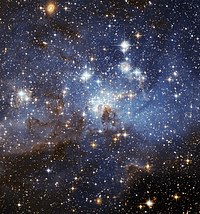
Photo from wikipedia
We study the effects of accretion environment (gas density, temperature and angular momentum) at large radii ($\sim 10$pc) on luminosity of hot accretion flows. The radiative feedback effects from the… Click to show full abstract
We study the effects of accretion environment (gas density, temperature and angular momentum) at large radii ($\sim 10$pc) on luminosity of hot accretion flows. The radiative feedback effects from the accretion flow on the accretion environment are also self-consistently taken into account. We find that the slowly rotating flows at large radii can significantly deviate from Bondi accretion when radiation heating and cooling are considered. We further find that when the temperature of environment gas is low (e.g. $T=2\times 10^7$K), the luminosity of hot accretion flows is high. When the temperature of gas is high (e.g. $T\geq4\times 10^7$K), the luminosity of hot accretion flow significantly deceases. The environment gas density can also significantly influence the luminosity of accretion flows. When density is higher than $\sim 4\times 10^{-22}\text{g} \text{cm}^{-3}$ and temperature is lower than $2\times 10^7$K, hot accretion flow with luminosity lower than $2\%L_{\text{Edd}}$ is not present. Therefore, the pc-scale environment density and temperature are two important parameters to determine the luminosity. The results are also useful for the sub-grid models adopted by the cosmological simulations.
Journal Title: Monthly Notices of the Royal Astronomical Society
Year Published: 2018
Link to full text (if available)
Share on Social Media: Sign Up to like & get
recommendations!